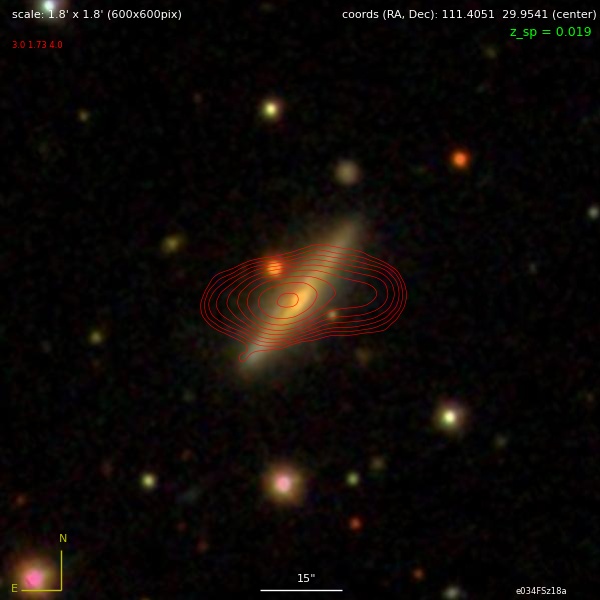ARG0001qbk - overlay
-
 by
Dolorous_Edd
by
Dolorous_Edd

Posted
-
 by
JeanTate
in response to Dolorous Edd's comment.
by
JeanTate
in response to Dolorous Edd's comment.
I posted one too, but it's buried deep in the Hourglass sources associated with spiral galaxies thread (~halfway down p13):

Of course, at the time I didn't know that it was in the ARG0001qbk field! 😉
But, having done that overlay (it's an extremely unusual object, AFAIK the only one reported in the literature), I was almost certain that that's what sisifolibre had found ... 😃
Posted
-
 by
42jkb
scientist, admin
by
42jkb
scientist, admin
Looking to the left in the FIRST larger image, it looks like this may be the lobe of the compact galaxy to the left. This may be on of those chance alignments.
What is AFAIK?
Posted
-
 by
Dolorous_Edd
in response to 42jkb's comment.
by
Dolorous_Edd
in response to 42jkb's comment.
What is AFAIK?
Short for: "As far as I know"
Posted
-
 by
sisifolibre
by
sisifolibre
It can be a alignment with the compact to W as said 42jkb. The radio morphology not seem to be aligned with the axis of the galaxy. But coincidence seems too much, or not?
In the overlay of Jean it can be observed some relationship between the morphology of their appearance on radio and optical.
possibly I am going to say some silly thing in any case I have basic questions about it, if anyone can help ... sorry for my ignorance
@JeanTate, with the rarity of this object you refer to appears to be a sDRGN? shoud not be an hourglas? or do you refer to another type of object?
@42jkb, the compact (J072544.28+295710.6) and the disc (J072537.22+295714.7) galaxies have a similar z, sould be a similar case to this one? http://radiotalk.galaxyzoo.org/#/subjects/ARG0002us5. Might the compact galaxy to be attracting material of the disc?
Posted
-
 by
42jkb
scientist, admin
in response to sisifolibre's comment.
by
42jkb
scientist, admin
in response to sisifolibre's comment.
That is a very interesting source that you have linked to.
As to whether the compact galaxy is attracting material from the disk depends on the type of interaction between the two galaxies and which one is more massive. I find the SDSS image rather odd and is that really jets or another galaxy in the foreground?
Posted
-
 by
JeanTate
in response to 42jkb's comment.
by
JeanTate
in response to 42jkb's comment.
Emonts, B. H. C.; Tadhunter, C. N.; Morganti, R.; Oosterloo, T. A.; Holt, J.; Brogt, E.; and van Moorsel, G. certainly think that the edge-on spiral is the host of the radio emission: "The disc-dominated host galaxy of FR-I radio source B2 0722+30" (ADS abstract), as do Capetti+ (2000) ("A Hubble Space Telescope snapshot survey of the B2 sample of low luminosity radio galaxies ... All host galaxies are luminous ellipticals, except one which is a spiral galaxy, while another one turns out to be a misidentification ...")
Here's what Capitta+ have to say about this host:
0722+30: The only source of the B2 sample associated with a spiral galaxy. It is a highly inclined galaxy which fills the PC field of view. Strong absorption is associated with its disk and a bulge-like component is also clearly visible. The radio emission originates from two symmetric jet-like features at an angle of
45o to the disk.Posted
-
 by
sisifolibre
by
sisifolibre
Instead of attracting matter I wanted to ask if they were interacting, sorry.
In SDSS image of J011924.13+122648.6 (Mrk 984) I can see that the system has marked other photometric objects and identifies them as other galaxies, but I would say that they are some kind of jets or a distortion of the galaxy, although I know that the jets that we see in RGZ are not seen in the visible spectrum. Other times I've seen marked objects like galaxies were just flashes of the stars and other things.
On the other hand, If i click in Mrk 984 "ADS search" I see references to articles as this one: http://arxiv.org/abs/astro-ph/0603032. These papers seem impossible to understand for someone with my knowledge but I understand that there are a strong interaction.
When i ckick in SDSS J072537.22+295714.7 "ADS search", the papers seems to be related whith others objets. The truth is that i don't know look good in ADS, and it is quite difficult for me.
The case is that it looks like (for me) a similar possibility: a disc that presents one lengthening of his emission in radio in direction of the elliptical one. And that's why I ask if there might be an interación between two galaxies.
Posted
-
 by
sisifolibre
in response to JeanTate's comment.
by
sisifolibre
in response to JeanTate's comment.
Thanks Jean. According to this description is a doublelobe and the question I asked you is answered (I think...).
Posted
-
 by
JeanTate
in response to sisifolibre's comment.
by
JeanTate
in response to sisifolibre's comment.
In SDSS image of J011924.13+122648.6 (Mrk 984)
Here it is (DR12):
but I would say that they are some kind of jets or a distortion of the galaxy
I did a quick check of the literature and could find no mention of any optical jets (doesn't mean there aren't any, just that I could not find any; there are a LOT of papers which include observations of this galaxy). Also, to me it's not so much jets as 'tidal debris' from the interaction with the massive elliptical (off stage, up).
although I know that the jets that we see in RGZ are not seen in the visible spectrum
They're certainly rare, but they do exist. Perhaps the most famous is that of 3C273 ...
By the way, there are even x-ray jets!
Posted
-
 by
sisifolibre
in response to JeanTate's comment.
by
sisifolibre
in response to JeanTate's comment.
I agree jets not seem good definition anyway 😛. These "tidal debris" can be considered a distortion of Mrk 984? What causes the light that can be seen in visible spectrum? Are only stars forming a kind of new arm of the galaxy? I do not think so because it seems to come from the core of the galaxy but i don't know...
They're certainly rare, but they do exist. Perhaps the most famous is
that of 3C273 ...I didn't know this, thanks.
But finaly we are speaking more about Mrk 984 that about the subject which causes this thread....
Posted
-
 by
sisifolibre
by
sisifolibre
Emonts 2009: "We argue that interactions between B2 0722+30 and nearby systems could be related to the triggering of the radio source"
http://radiotalk.galaxyzoo.org/#/subjects/ARG0003ayb may be a similar case
can we use any hastag for these cases? or to create one?Posted
-
 by
JeanTate
in response to sisifolibre's comment.
by
JeanTate
in response to sisifolibre's comment.
Merger/interaction induced radio emissions? Certainly an interesting topic! 😃
can we use any hastag for these cases? or to create one?
Perhaps we could create a hashtag? How about "RbyM" (radio emission by merger)?
Posted
-
 by
sisifolibre
in response to JeanTate's comment.
by
sisifolibre
in response to JeanTate's comment.
I do not know if it could be useful, but a new hashtag neither bothers too much...
Hashtag Could be " RbyI " (Radio emission by Interaction)?.
Correct me if I'm wrong, but in my opinion merger implies some class or state of collision. I think there are other interaction kinds among galaxies which do not involve collision...
Posted
-
 by
JeanTate
in response to sisifolibre's comment.
by
JeanTate
in response to sisifolibre's comment.
Correct me if I'm wrong, but in my opinion merger implies some class or state of collision. I think there are other interaction kinds among galaxies which do not involve collision...
You're right. However, my impression, reading astronomy papers, is that 'merger' is sometimes (often?) used as a shorthand for 'a galaxy interaction that produces apparent disruption/distortion in at least one of the interacting galaxies', even if it does not involve a 'collision'. One reason for this may be that it's very difficult, in most galaxy interactions, to determine if that interaction will (eventually) lead to a merger. Also, particularly in the case of 'minor mergers' (i.e. where the estimated mass ratio of the two interacting galaxies is greater than 4), the smaller (less massive) galaxy in a merger may end up in some sort of orbit around the the more massive one; if that orbit includes a 'close encounter' - where the two galaxies come 'close', but do not 'collide' - it is likely that the smaller galaxy will be shredded, reduced to a 'tidal stream', and much of its mass 'captured' by the bigger galaxy.
Astronomy sure is fun, isnt it! 😄
Posted
-
 by
sisifolibre
in response to JeanTate's comment.
by
sisifolibre
in response to JeanTate's comment.
Astronomy sure is fun, isnt it!
no doubt !!
Ok, then #RbyM, I would like to know how many of these there are in RGZ...
Posted